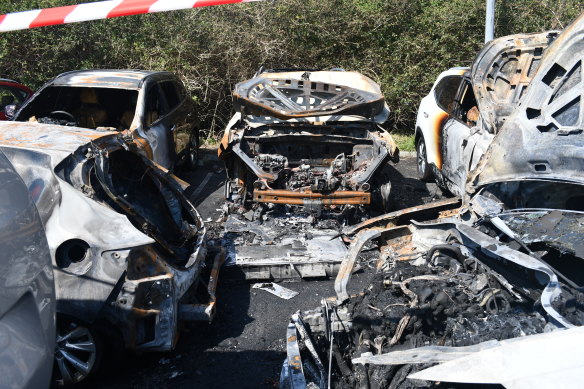
Are all devices with these batteries at risk of exploding?
The short answer is yes, but the risk varies greatly depending on the device. Generally speaking, there are a few major factors that can cause devices with lithium-ion batteries to become dangerous: either they get physically damaged, or the battery itself is poorly made or incorrectly charged.
If you’ve ever wondered why we don’t see too many reports of smartphones or tablets catching fire, it’s because these factors are minimised. People tend to be cautious handling these devices because of their glass screens, and the devices tend to be well manufactured by reputable companies. Devices such as earbuds, watches, laptops and portable game consoles are mostly in the same category, and make up a tiny amount of the fires caused by lithium-ion batteries.
Fire and Rescue NSW’s Daniel O’Dea, team leader of alternative and renewable energy technologies, said small, inexpensive devices such as vapes often caused fires when thrown in the rubbish and compacted but e-scooters and e-bikes were some of the most common culprits in the home.
Loading
“A lot of the good-quality e-bikes and scooters can be really expensive. So people often opt for a cheaper product which will have a poor quality battery or battery management system in it,” he said.
“Or alternatively, what people do is they change the battery, so they rip the battery out and they might buy a non-genuine battery pack online. In some cases, they’re even trying to build their own battery pack. And we’ve unfortunately seen that time and time again with tragic outcomes.”
The same applies to portable power banks — quality models can be very expensive, but cheap ones come with a higher risk of failure.
How can battery fires be avoided?
Fire agencies around the country all have similar advice, including buying products from reputable sellers, ensuring the use of compatible chargers (not merely ones with plugs that fit), checking for damage, using smoke detectors, and charging large devices such as scooters and bikes away from living areas.
However, some agencies also list advice that seems unlikely to be followed by most consumers, such as only using chargers and cables that come with their devices and avoiding charging any devices while they sleep.

Electric car batteries cars can also catch fire if damaged or improperly charged.Credit: Fire and Rescue NSW
O’Dea said the advice was designed to point out risks that everyone should be aware of and consider to best minimise risk.
“With phones and tablets, if you buy good-quality products and use good-quality compatible chargers, it’s not a major risk. The good-quality products have good battery management systems in them. Even laptops, the incident numbers are really low,” he said.
Will fires only increase as battery devices become more prevalent?
Reports of damaging electric vehicle fires and tragedies caused by e-scooter explosions are already quite common, even though the devices aren’t as popular as they probably will be in the future. But Swinburne’s Hussein Dia, professor of future urban mobility, said the percentage of failures would likely fall. Battery designs would get better, and people woud become more educated about battery safety.
Loading
People driving combustion engine cars would rightly be alarmed by a grinding engine noise or the smell of petrol, he said, but drivers of electric cars might ignore battery warning lights on their dashboard or the sound of a large crack from a damaged battery.
“People will understand that, you know, I shouldn’t have ignored that message, or I shouldn’t have ignored that the battery was bulging,” Dia said.
“If I buy a charger or a battery bank, I’ll have to be satisfied it meets safety standards. And I’ll just unplug devices before I go to bed if it’s already at 80 per cent or 90 per cent.”
Dia also said that while e-scooters and bikes were a unique risk, their status as a new technology meant that their failure was covered more often in the media, making the risk seem higher. Similarly, electric vehicle fires were reported constantly despite fires in petrol vehicles being far more common.
“There are a large number of fires, even in homes, due to other electric devices that don’t get as much attention. These are novel devices, and people want to understand if they are at risk,” he said.
“So it’s good to have educational campaigns around it, so people understand the nuances.”
Get news and reviews on technology, gadgets and gaming in our Technology newsletter every Friday. Sign up here.









 Add Category
Add Category